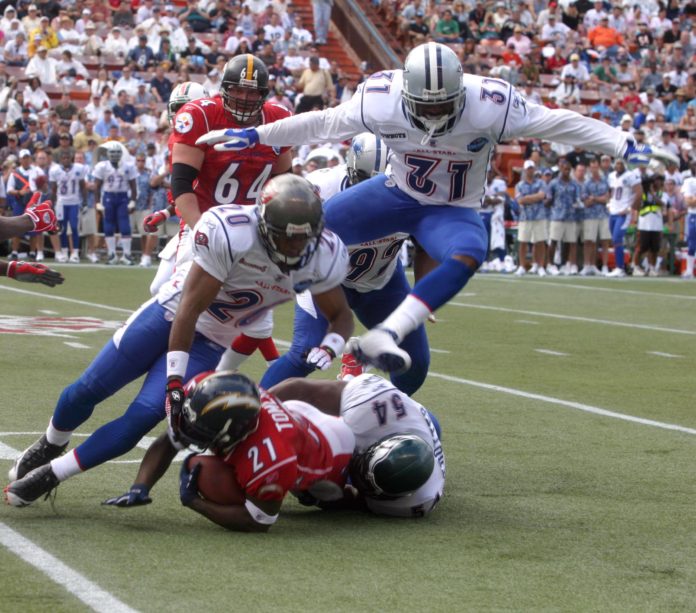Recently a study was published in The New York Times that was performed by a neurologist named Dr. Ann McKee. Her study focused on the brains of 202 former football players. These players were all deceased, but either they or their families had allowed for their brains to be studied post-mortem. Of those 202 brains that were studied, 111 of them were former NFL players. The other 91 were those of former college, semi-pro, or high school football players. For this article, we will focus on those who played in the NFL, but to get a fuller picture, check out the Times article.
The purpose of this study was to uncover the prevalence of the brain disease known as Chronic Traumatic Encephalopathy (C.T.E.) that is caused by repeated head trauma and that can only be discovered post-mortem. This disease has only recently come to light due to Dr. Bennet Omalu’s discovery of an Alzheimer’s-like disease in the brain of Mike Webster, a former Pittsburgh Steelers offensive lineman, as depicted in the 2015 movie Concussion starring Will Smith. C.T.E. has a multitude of symptoms, such as decreased cognitive function, depression, and memory loss, and it can have physical symptoms such as tremors. Due to the incredibly physical nature of the sport of football, one may draw a logical connection to brain trauma and the sport. While this discovery was only observed on one brain, it led to a much larger question: exactly how big is this problem in the game of football?
Here is where we return to the study recently done by Dr. Ann McKee to answer this question. Of the 111 brains of former NFL players she studied, 110 had C.T.E. Nearly every position on the field was tested and the results showed that, when compared to the general population, former football players have disproportionately higher rates of C.T.E. Not only that, but 87% of the total 202 former athletes were found to have C.T.E. as well.
Although this is just one study, it raises questions around one of America’s most beloved sports. After all, NFL Sunday is essentially a holiday in the United States. Jim Harbaugh, the current coach of the University of Michigan football team, has called football “the last bastion of toughness for American men.” With this sport so ingrained in the culture of our country, is it reasonable to believe that we will see drastic changes anytime soon?
Thus far, the biggest changes to the game have been new targeting penalties against players who hit defenseless opponents in the head or neck region using the crowns of their helmets, their shoulders, or their forearms. In NCAA football, if a player gets a targeting penalty, they are automatically ejected from the game. The NFL has recently passed a rule also prohibiting unnecessary roughness against defenseless players, and it imposes fines on players for egregious hits. If a referee determines a hit to be “flagrant,” the player may be disqualified from playing for the remainder of the game. Of course, the problem with this is a flagrant hit to one referee may not appear flagrant to another, leaving room for subjectivity, and the NFL has been criticized for not imposing stricter rules. For more on that I’d recommend the Washington Post article about the NFL’s targeting rule by Adam Kilgore. Another recent rule change has been moving the kickoff from the 30-yard line to the 35-yard line to prevent high-speed collisions.
While these new rule changes have proven to make the game safer, the inherent nature of the sport has remained untouched, which some would argue is the problem. Some NFL players have been retiring earlier in their careers to prevent excessive injuries, such as former Detroit Lions marquee wide-receiver Calvin Johnson who retired at the age of 30 after 9 seasons of pro ball. Johnson did a great interview with Michael Smith of ESPN in which he opened up about his choice to retire from football at a relatively early age that is worth a watch if you have any interest in the topic.
Due to the sport relying so heavily on physicality, hitting, and tackling, it is an unforgiving tightrope that NCAA and NFL officials are tasked with walking. On the one hand, football has been linked to brain trauma in players, leading to a moral outcry from the public to protect the athletes on the field. On the other hand, the sport itself is specifically designed to be played in a highly physical, hard-hitting manner. So the question remains: where do we go from here?
Although Transylvania does not have a football program, there are still many football fans here on campus who have opinions on what the future of football holds.
Senior Ty Alderman stated, “The next step will be an increase in the amount of money spent on the equipment for the players in order to better protect them.” He went on to say, “I don’t think they can change football any more than they already have.”
Junior Bailee Stevens expressed a similar sentiment. She stated, “I do believe that there will be a much stronger focus to improve the technology that goes into helmet safety and gear, as well as routine checkups on the players to make sure that there aren’t internal injuries that are going unnoticed.”
While these were more mild opinions, some were much more drastic, such as that of junior Jose Espinoza who stated, “I think in thirty years we are going to look back and think, ‘Why did we do that?’”
Although opinions abound, the future of football remains uncertain. Obviously this issue can be discussed through many different lenses from civil rights to public health, but for now it could be viewed simply as a discussion that the public needs to have. As more and more studies come out, and more players continue to retire early, nobody can say with certainty what is in store for one of America’s most popular sports.



